Guiding Promise Badges
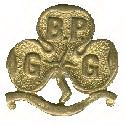
The Promise Badge is the most important badge a member can receive – it is a sign of the lifelong commitments she has undertaken at her special Promise Ceremony, and, particularly in the early days, the badge was described as the Guide’s ‘life’, and being asked to surrender it to the Guider, even temporarily, was considered the ultimate punishment which could be given for misdemeanours. Yes, the Promise is a lifelong commitment – for all their life, whether long or short, whether they stay in the movement long-term or leave soon after making it, they are committing themselves to the ideals in the Promise. And in return for that commitment, they receive their special Promise badge, a tangible reminder of the Promise they made, pinned on by the person who received their personal commitment.
Although dates are given below for when new designs were introduced, it should be stated that these are simply the dates when stocks of the new badges first became available nationally – many Guiders would have used up their supplies of older styles before obtaining/starting to issue new-style badges, so there may be instances where what you received doesn’t match the dates stated below – I have known of oval 1940s Brownie Promise badges being issued into the 1950s! Equally, different manufacturers were used, sometimes simultaneously, so all sorts of minor variations in shape, style and colour can be seen – the pictures below should be taken as typical versions only, and do not show every version or variation which can be found!
Each part of the Promise Badge has a meaning. As with the Scout Promise Badge (the fleur de lys) the Guide Promise Badge (the trefoil) has 3 leaves, to symbolise the three main elements of the Promise (faith/belief, national loyalty, service). It originally had two Gs, to indicate the promise and law, and a star with 5 points (and therefore 10 if you count the ‘inner’ points too) to symbolise the original 10 Laws. At the base is a scroll which was said to be in the form of a heraldic feu or flame, and a compass vein pointing upwards to show the direction a Guide should always aim.
The Promise Badge for the Guide section has always been produced in brass or brass-coloured metal. You may see versions in silver (or later silver-coloured) metal – these were Commissioner Promise Badges. Also, prior to 1994, Guiders wore their last youth Promise Badge, so for some that would be a Ranger or Cadet Promise Badge, for many a Guide Promise Badge. If someone had not been a member in their youth, then when they made their Promise they received a Guide Promise Badge. In 1994 a special Promise Badge for Guiders was introduced, to be worn instead of their Brownie/Guide/Ranger/Cadet Promise badges.
Over the years, Guiding Promise Badges have changed in style many times. I hope to gradually add to this page, including pictures of the different badges and variations for each section. If you spot any errors, can confirm any vague details, or can fill in any of the blanks, please do let me know!
Rainbows
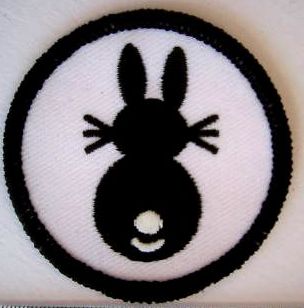
Before Rainbows existed, in Northern Ireland there were Bunnies. Their Promise Badge showed a seated rabbit in black, on white.
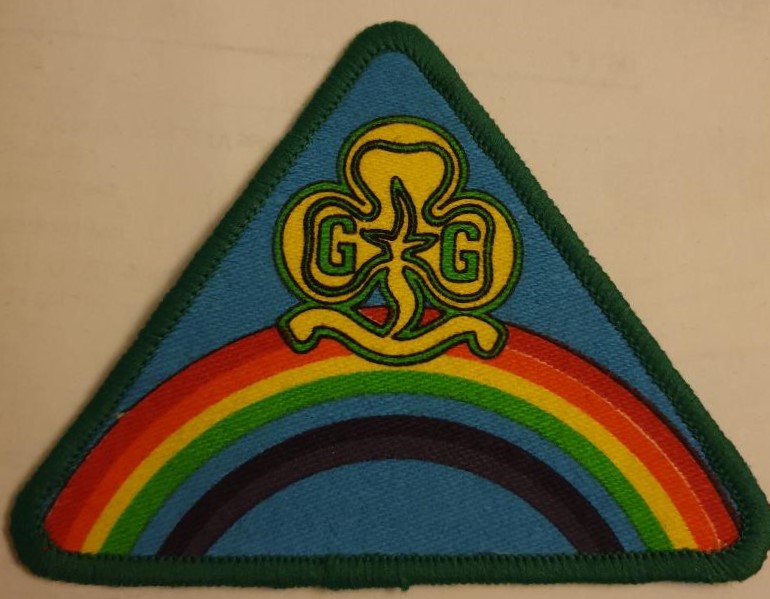
The original Rainbow Promise badge was a triangular cloth badge, featuring a Rainbow under a Guide Badge. It was sewn against the neckline of the tabard, with the upper point of the triangle meant to touch against the binding on the top edge of the tabard.
The original version of it was a printed badge, as shown on the right, with the green printed edges on the Promise-badge part.
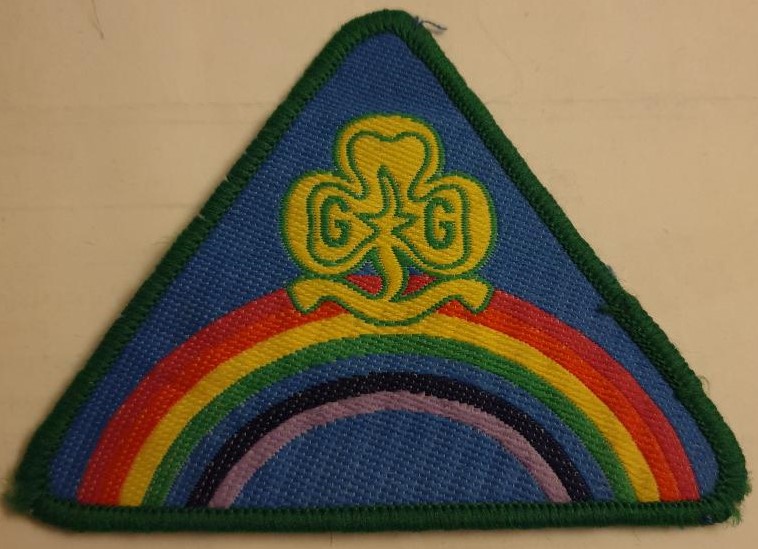
Later, a new embroidered badge was introduced, the green edges on the Promise Badge logo were less prominent, and the purple stripe of the rainbow was a much lighter colour.
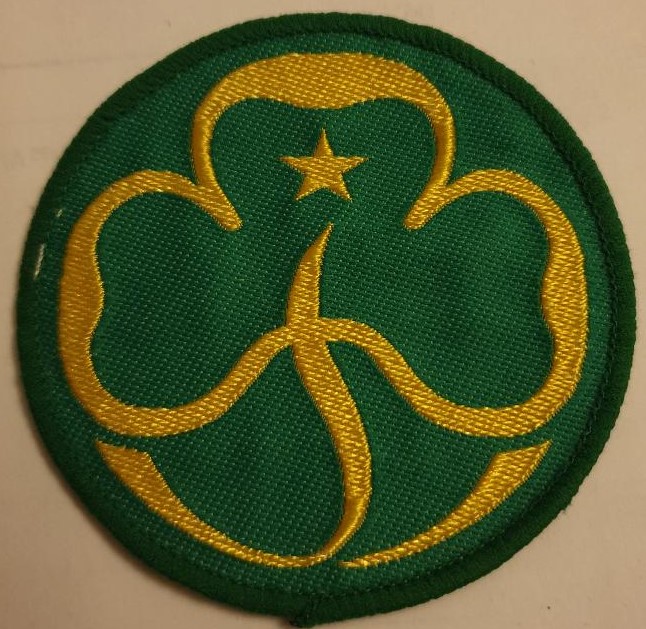
It was then changed to fit in with the other section promise badges, and was a yellow trefoil on green – again a cloth badge, as it was considered unsafe for Rainbows to have metal badges. A separate felt rainbow was later made available to sew above it.
Souvenir sets of the different Promise badges of this era were sold on a card, which included a metal version of the green Rainbow Promise badge, which may cause confusion . . .
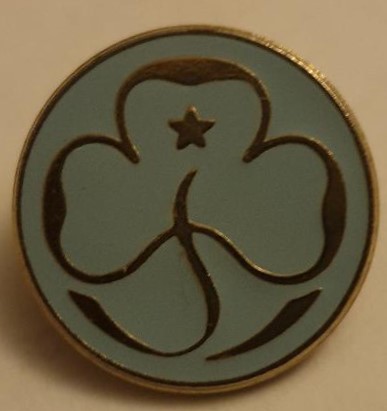
A metal badge was introduced with a sky blue background, to match the new Rainbow uniforms which were brought in.
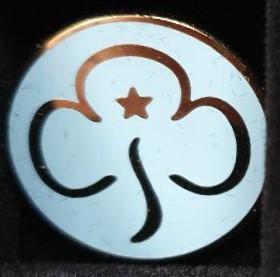
However it wasn’t long before all of the Guiding Promise badges changed to a newer style, in 2005.
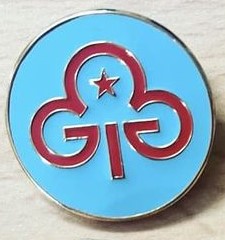
A rebranding exercise in March 2023 brought new Promise Badges for all sections, including Rainbows, whose Promise Badge was now much brighter, being in red as well as a stronger shade of pale blue.
Brownies
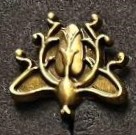
Originally, the section were called Rosebuds, and had a badge featuring a Rosebud, designed by the founder of Guiding, Agnes Baden-Powell.

It wasn’t around for long, as by 1917, it had been replaced by a new badge, an acorn within a brown circle. It is believed that the acorn badge may sometimes have had holes either side for sewing on, rather than a pin, and they aren’t always made of metal, sometimes they are disks of a thin plastic-like material.
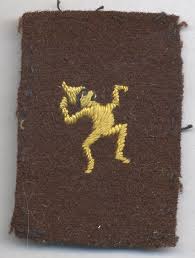
During World War 1, with supply shortages, some Brownies had a cloth badge, with the brownie figure embroidered in yellow thread, on a brown felt-like background.
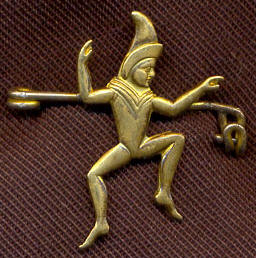
By the 1920s the ‘Brownie Man’ figure was made in brass with a thin wire pin fastening, but this was found to be very flimsy, and breakages of these were common.

By 1932 he was shown on a broader metal bar, which was sturdier (although there was still a risk of the arms and legs becoming bent during cleaning as they got caught in the polishing cloth), and this design continued more or less unchanged through to 1968, except . . .

Wartime restrictions meant that the cutout Brownie man was too time consuming and wasteful of materials to manufacture, so two alternatives were introduced, both of which featured the ‘Brownie Man’ design stamped into a piece of soft brass – initially a rectangular design was used, with a pin welded on the back.
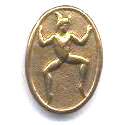
From 1942 and then for the rest of the war, a smaller and more economical oval shape which used less metal, and didn’t have the sharp corners. There is also evidence that during war, the metal badges may have been unobtainable at some points – certainly, during wartime there were general problems with Guiding equipment supply, both through factories focussing their efforts on producing war goods, and the shortages which could be caused by the bombing of warehouses, transport routes, imported materials etc.

The next change came in 1967, amid the major programme changes which took place for all sections. To show that Brownies were a full part of the Guide family, they now became ‘Brownie Guides’, and a Guide Trefoil was incorporated into the design of their Promise badge to show this, surrounding the ‘Brownie Man’ in a hollow design – and now in a silver-coloured metal which did not need polishing.
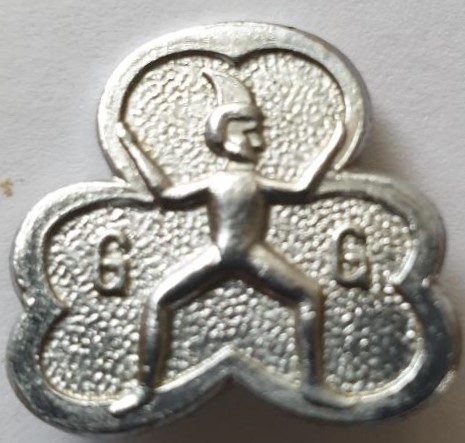
However, again, cost came into play – the intricacies of the cut-out were proving too expensive, so in 1971 a revised design was brought out, which did away with these issues by having a solid, filled-in background, and which featured the GG letters as seen in the other section Promise badges of the time. Later, they style of pin was changed from a normal clip style, to one with a revolving safety catch.
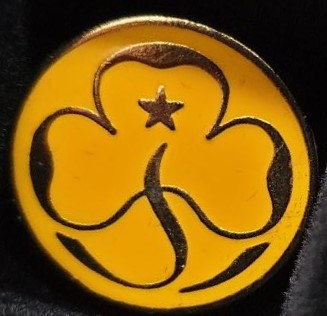
The next change came in 1994, with the introduction of more closely linked Promise badge designs for all of the Guiding sections, so it was back to being a brass colour (strange how so many changes in Guiding involve changing back to what went before!), with the Brownie badge featuring the re-styled trefoil, on a dark-yellow mock-enamel background.

That style didn’t last for long, because they changed the style of the Guiding logo, so had to change the Promise badges. They kept the same Promise badge styles and colours, so the 2005 Promise badge featured the new-style trefoil on a dark-yellow background, as shown.
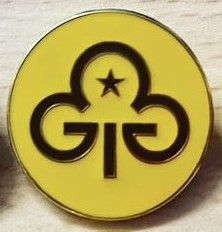
In March 2023 it was announced that new Promise Badges were being introduced for each section, featuring the new Girlguiding Logo in section colours. The Brownie one continued to feature the logo in a brass colour, on a lighter-yellow background than before.
Guides

The original Girl Scouts used the Brass Scout Promise badges and insignia, and continued to do so as Guides until such time as Guide ones became available – the date for this varied around the country – but from around May of 1910 the new promise badge became available – a brass trefoil with BP on the topmost leaf, and G G on the two side leaves, the three leaves being considered to denote the sections of the threefold Promise and the lettering designed to indicate that they were ‘Baden-Powell Girl Guides’ to distinguish them from the various groups (sometimes referred to as “Monkey Patrols”) which sprang up keen to copy some of the elements they found to be fun, and to skip those which seemed dull and worthy, like obeying the Laws and doing good turns! Guides were expected to polish their brass Promise badges, both front and back, every week – and Guiders would often check to see that they had – hence some vintage badges are almost polished smooth!
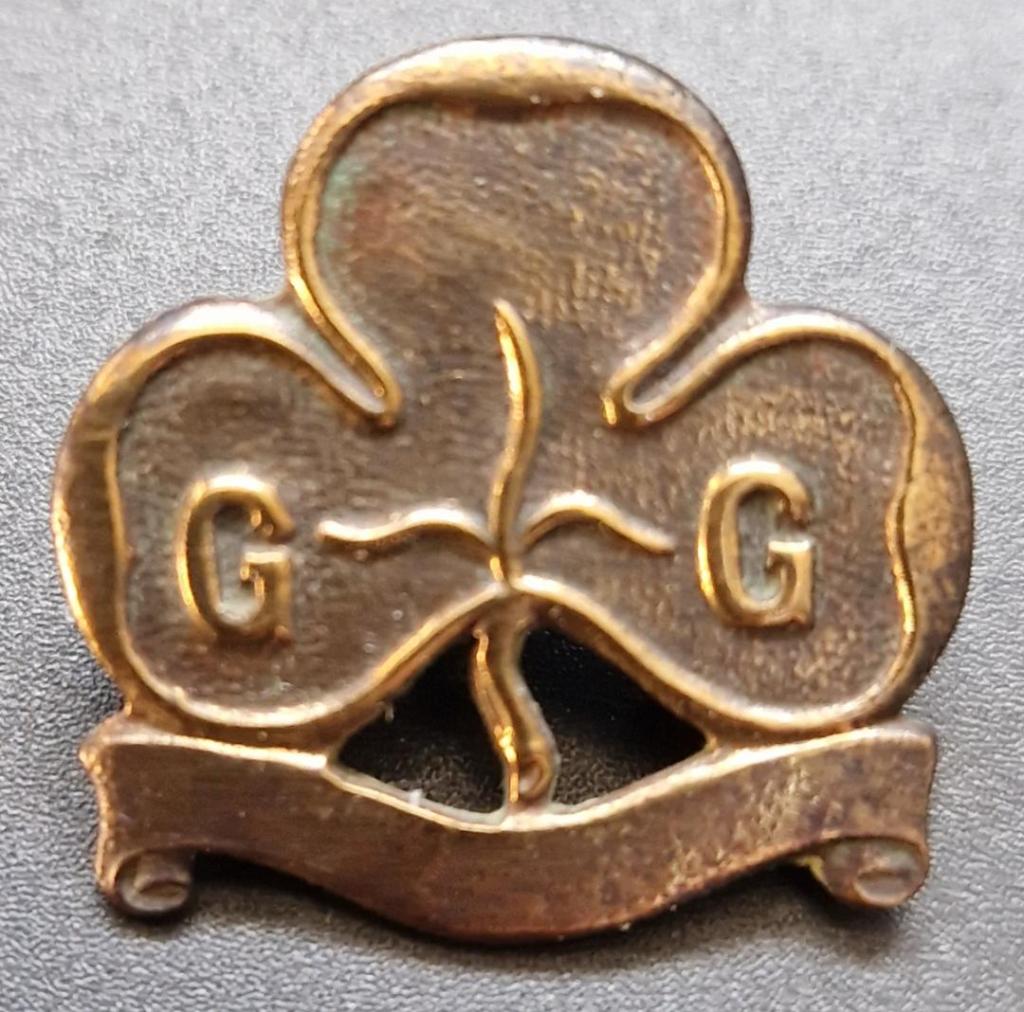
By 1921 the BP lettering was gone, (probably because the issue of ‘Monkey Patrols’ had died down) and the trefoil featured a wider, blank scroll.
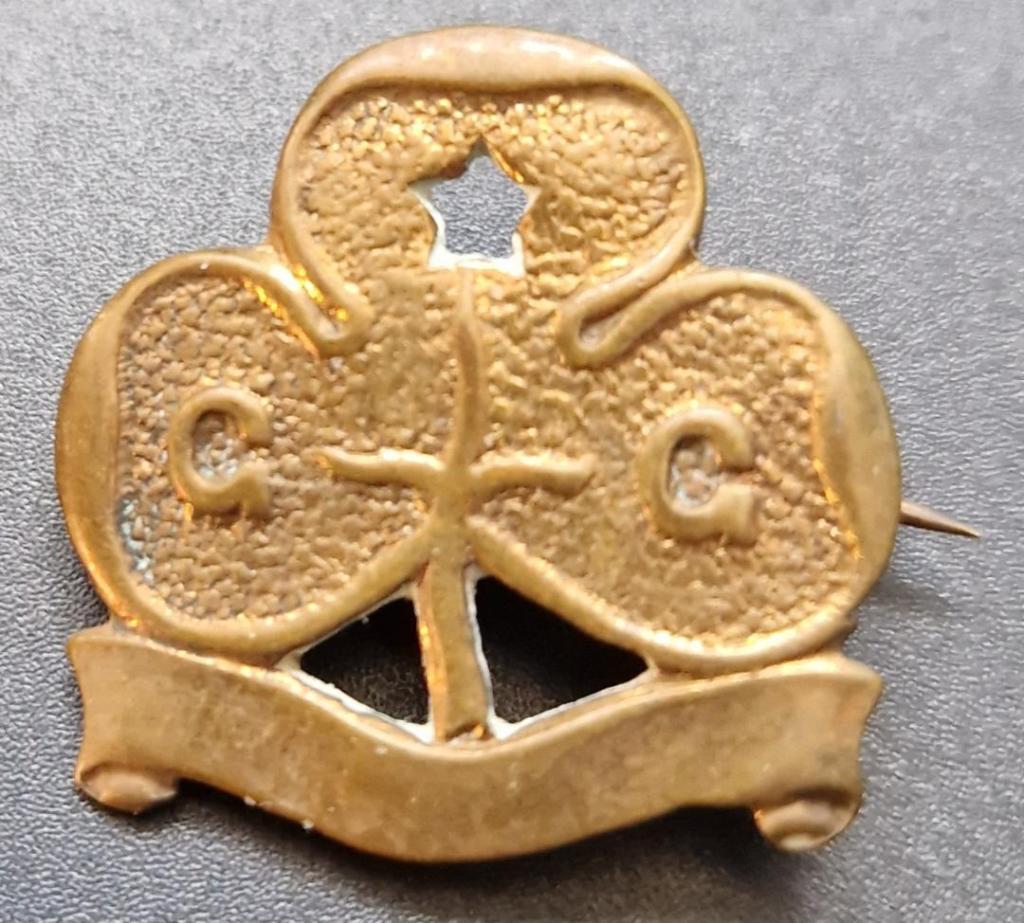
Soon it appeared with a cut-out 5-pointed star in the middle of the top leaf – each of the inner and outer points of the star being said to represent one of the then 10 Guide laws, as an extra aid to remembering them. The stem also started to straighten.
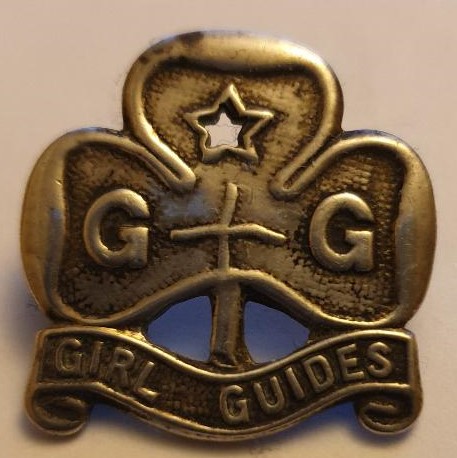
In 1932 it was altered again, this time to have a straight stem and stalk rather than a curving one, and the text ‘Girl Guides’ was added along the scroll – this is the most commonly seen design, as it was around for the longest time – from 1932 right through to 1968, which was also the era when Guide membership was at it’s highest. It appears that, unlike with Brownie badges, production of this design was able to carry on right through World War 2, as I have not been able to trace any sign of shortages beyond the general ones, or of alternates being used.
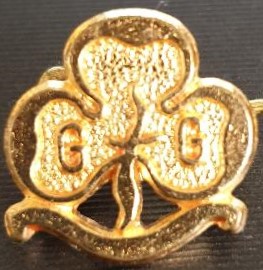
In 1968 it changed once again, now having a much narrower scroll, which was plain again. The star also disappeared, and the stem curved again. Indeed, apart from having flattened scroll-ends rather than shaped ones, and it now being in a metal which did not need polished rather than being in proper brass, the new badge was really rather similar to the Promise Badge of almost fifty years before – don’t be confused!
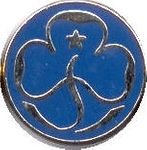
1994 brought the standardisation of Promise Badges across all the Guiding sections, the Guide Promise Badge being a trefoil on a mid-blue artificial-enamel background.
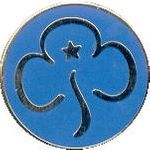
A new logo was introduced in 2005, with the new-style trefoil in a brass colour on a mid-blue background. It was in a slightly lighter shade than the previous badge, and as the Leader Promise Badge was now in a lighter shade than before, there can be scope for confusion.

This continued in into the 2020s. It was announced in March 2023 that a new logo was being launched for the organisation, and it was first seen on the new Promise Badges launched then. Each one showed the new logo in the new section colours. The Guide one retained the mid-blue background, but now with the trefoil itself in a light-blue shade. Perhaps accidental, but it could be seen as a nod to the original colour of the Girl Guide tie of the 1910s and early 1920s?
Senior Section
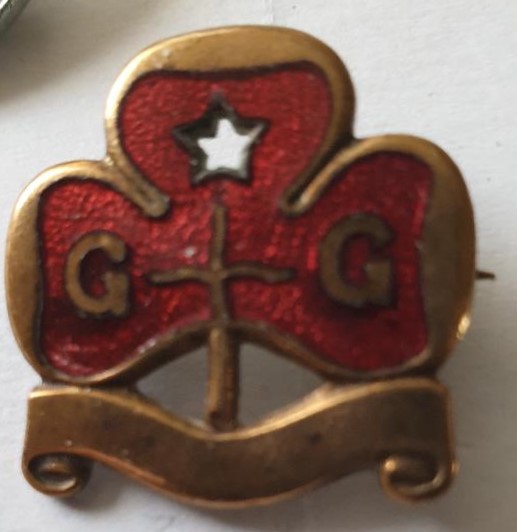
The origins of the Senior Section lie with Senior Guides, which started in around 1915, with their name changing to Rangers in 1917 – later known as Land Rangers to differentiate them from the specialist branches Sea Rangers and Air Rangers. Their original promise badge for Rangers was the same as the Guide one of the time, but with a red enamel fill. The alternative was offered of the Guide Tenderfoot Badge worn on a red felt background, as an economy option.
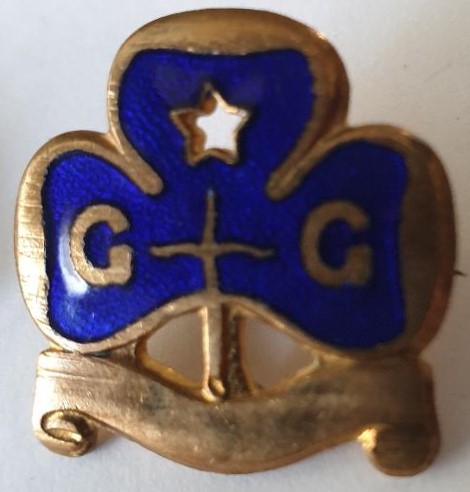
Sea Rangers were introduced in the early 1920s, and their promise badge was in the same style, but had a dark blue enamel fill.
When Cadets started in around 1916, their Promise badge had a white fill in the centre, with a navy blue fill in the tips of each of the trefoil’s leaves, the white colour echoing the army tradition of cadets wearing white fittings to their uniforms until qualified as officers.
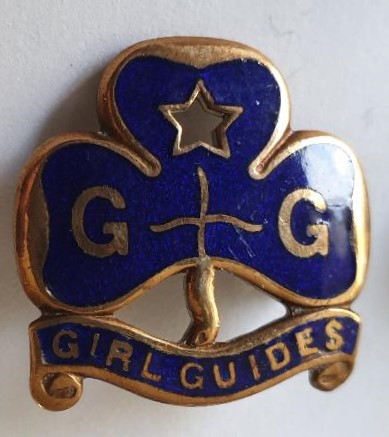
In 1932, as with Guides, the Promise badge for Rangers was altered to have a lettered scroll of “Girl Guides” at the bottom rather than the plain brass scroll – each of the Ranger section badges had enamel in the scroll as well as the main part of the badge. So from 1932 the Promise badge for Sea Rangers was in navy blue with a lettered scroll.
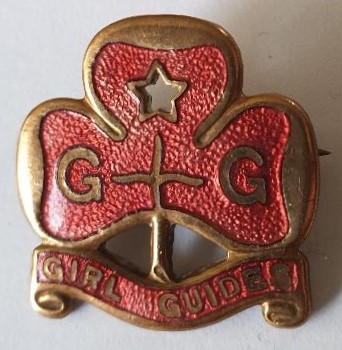
The badge for the Land Rangers was in red enamel, also having an enamelled lettered scroll. Some of the badges from this era tend to have somewhat of a convex shape to them, it’s not clear whether this was from a particular era or batch.
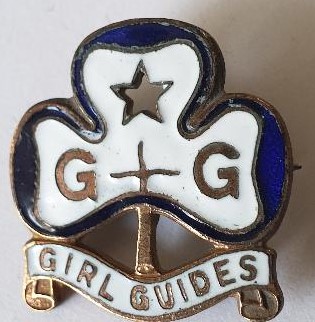
And the badge for Cadets was in white with navy tips on the trefoil leaves, and a white-enamelled lettered scroll.
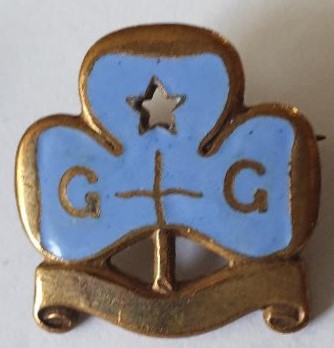
Air Rangers were introduced in 1945 – their Promise Badges had pale blue enamel (be careful not to confuse this with the lilac of Extension Guide Promise badges, or the aqua of post-1967 Ranger Promise Badges, the shades can be very similar!)
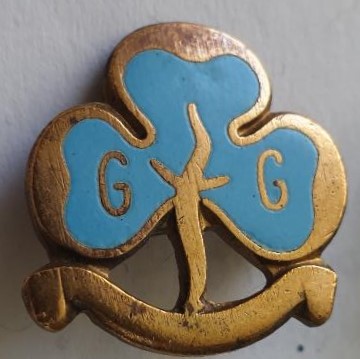
In 1967, the different Ranger sections and Cadets were abolished, the Land Rangers, Sea Rangers, Air Rangers and Cadets all simply became Rangers, and wore a Promise badge with aquamarine enamel, to match the new aquamarine blouses and aquamarine-piped navy air-hostess style hats worn as uniform

As transition took some time, there were some badges produced in the new trefoil-style but in the old section colours. I have seen these for Air Rangers.
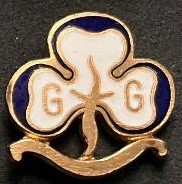
Cadet examples can be found, presumably there would have to be allowance for Cadet units to close down and complete the full training course of recently-joined members following the decision to close down the section and merge it into Ranger Guides.
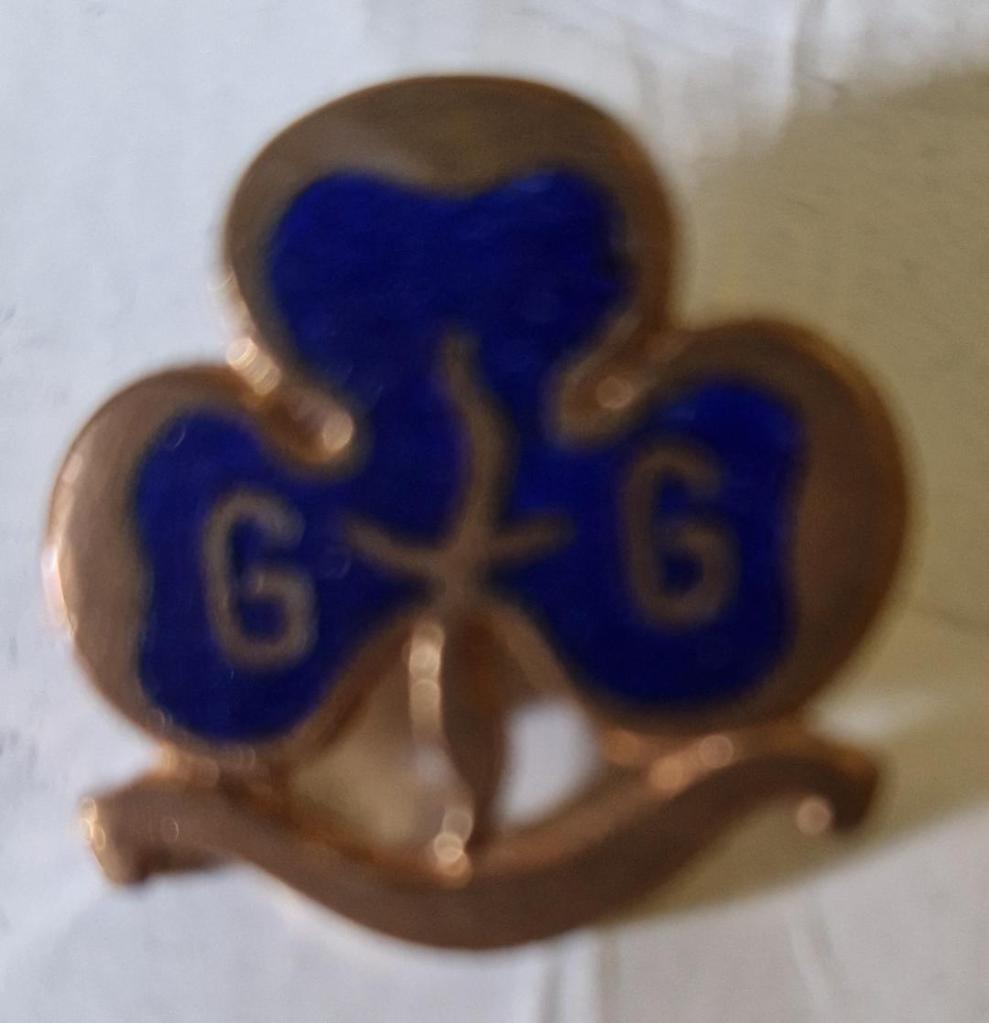
Sea Ranger examples of the new-style trefoil have also been seen, though we might expect them to be rare given units were scheduled to have been transitioning to Ranger Guide Service Section throughout this time. But the decision to close the Sea Ranger section proved especially contentious, with many Sea Ranger Ships campaigning to keep their uniform and identity – such that eventually it led to the founding of a breakaway Sea Ranger organisation.

In 1973, the Young Leader Section was started, with broadly similar aims to the pre-1967 Cadets, and although they wore the same aquamarine uniform as the Rangers did, they got their own Promise badge in the same style, but with white enamel.
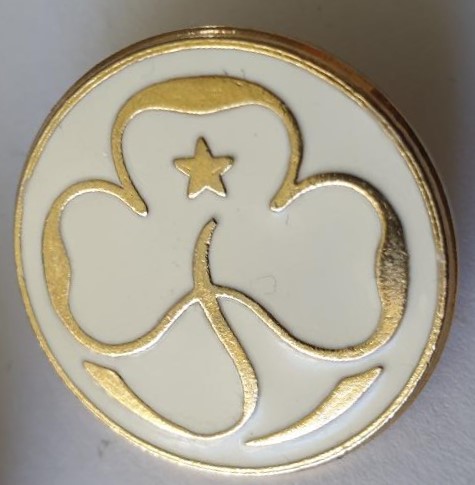
With the standardisation of Promise Badges across all the Guiding sections which was done in 1994, the Promise badges for Young Leaders featured the new-style trefoil with white enamel.
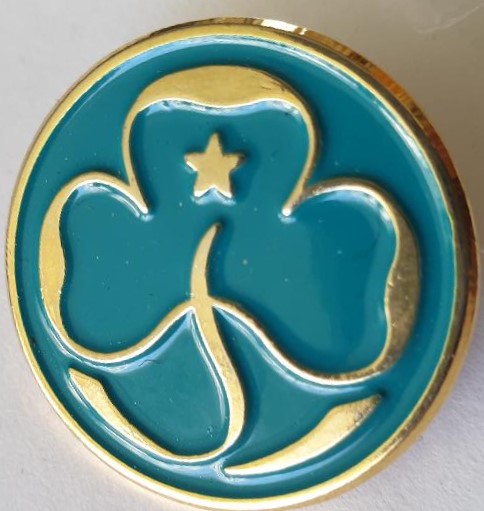
It also meant a change to the Ranger Promise badges to the newer-style trefoil, retaining their customary aquamarine enamel
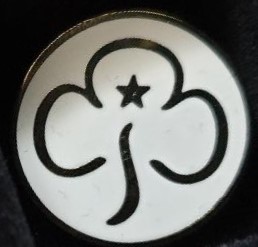
The Girlguiding UK logo changed in 2005, so a separate Young Leader Promise Badge (shown on right) was included, but shortly after was abolished, as they ceased to be a separate section and technically become part of a unified Senior Section – as had been tried in 1967. Again, this was backtracked on, Young Leaders returned, as did their separate Promise Badge
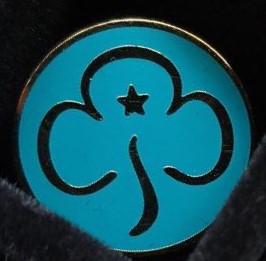
Of course, changes in trefoil style meant that the Ranger Promise Badge had changed too, though it remained aquamarine.

Then in March 2023 Girlguiding launched it’s new logo and branding, and as a result, new Promise Badges for each section. This involved a dramatic change for the Ranger Promise Badge, with a brand new colour – now it was maroon!
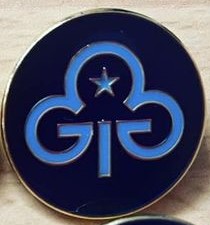
For Young Leaders it was a bit of change, and perhaps a bit of the past returning too – their traditional white was gone, but the navy was back, with the new badge being in navy blue with a mid-blue trefoil. It is very similar to the Guide Promise badge, the difference being the darker shade of navy in the background – and similar to the Guider Promise Badge in having a dark navy background, the difference being the trefoil in light blue rather than white.
Guiders
For most of the history of Guiding there was no separate Promise badge for Guiders. Up until 1994 the rule was that Guiders wore the Promise badge of the last section they were members in, or if they had not been Guiding members in their youth, on making their Promise as a Leader they received a Guide Promise badge. Commissioners wore special Promise badges which were identical to the ones for Guides, but in silver (later silver coloured metal).
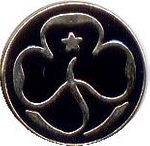
In 1994, in a departure from previous policy, a separate Promise Badge for Guiders was introduced, in the same style as those for the other sections with a trefoil on navy (almost black) mock-enamel, and the silver Commissioner Promise badges were no longer issued.
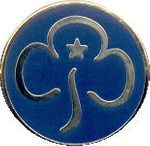
From 2005 the Guider Promise Badge featured the new style trefoil on navy enamel (it is a much lighter shade of navy than previously, as can be seen from the pictures, and may thus be at risk of confusion with the Guide Promise badge). This badge continued in use until the 2020s.
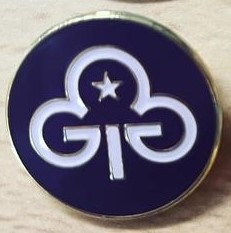
In March 2023 Girlguiding UK launched it’s new branding and logo, and the first place it appeared was on the new Promise Badges, which went on sale at that point. Both the old and new style badges continued on sale for a time.
From 1932 to 1968, as well as their Promise Badge, Guiders wore enamelled Warrant Badges, which served to indicate which section they worked with in their leadership role.
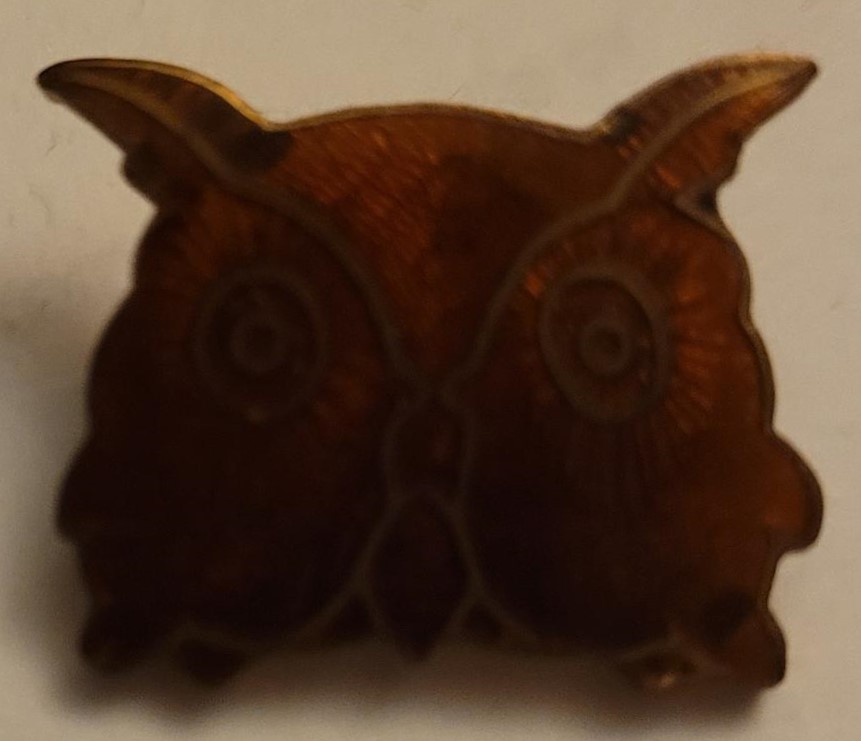
Brown Owls wore a badge featuring an owl’s head, with light-brown enamel (which varied in shade).
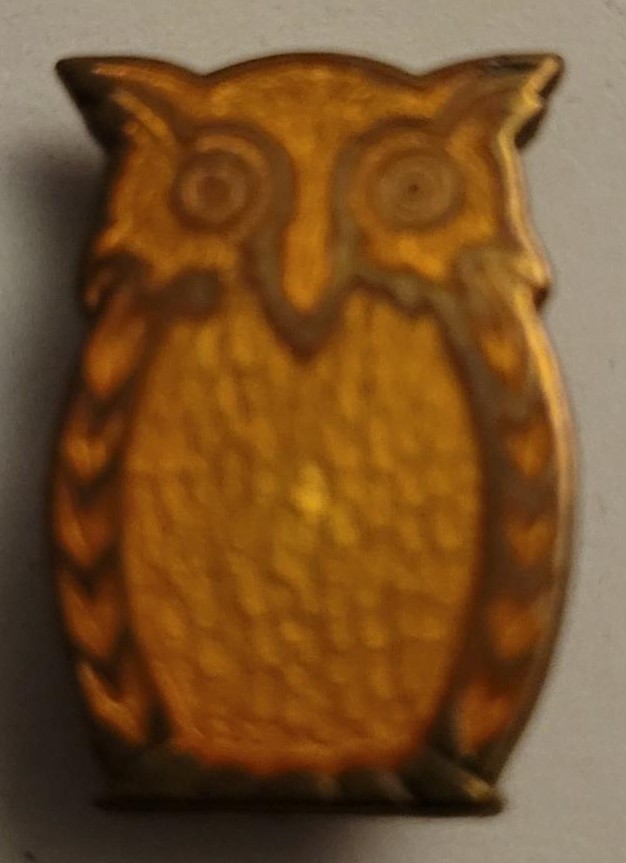
Tawny Owls wore a badge featuring a full-length Owl, which tended to have darker-brown enamel.
There were some Warrant badges made in the style of the Guide ones but with brown enamel – these were made only for Brownie Guiders in those countries of the Commonwealth where they followed the British Brownie programme, but did not use owls as part of it, either because the birds simply did not exist in that country, or because Owls did exist but had a negative image there. These brown-enamelled warrant badges are especially rare because they were only introduced in the 1950s and stopped in 1968, so comparatively few were issued – and only in the Empire/Commonwealth, not within the UK itself.

Warrant badges for Guide for Guide Captains had green enamel, as the infill. Warrant badges for Land Ranger Captains had red infill, just as the Land Ranger Proficiency Badges did. Warrant badges for Sea Ranger Captains had dark blue infill, again reflecting the colour of all the Sea Ranger badges. Warrant badges for Air Ranger Captains had light blue enamel – Air Rangers had been introduced at the end of World War II to encourage air-mindedness in Rangers. Cadet Guider Warrant Badges had white enamel – unlike the Cadet Promise Badges there weren’t any navy touches. Lieutenant badges (for all Guide/Ranger sections) were not enamelled
In the Republic of Ireland, badges of the same design are still issued as standard, something for collectors to be aware of, and check before paying large sums for what may turn out not to be vintage.
Trefoil Guild Promise Badges
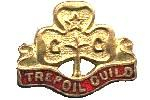
Trefoil Guild was officially founded in 1943, based on the assorted ‘Old Guides’ groups which had existed both unofficially and semi-officially from at least 1914 onwards. Until 1994, their Promise badge was a trefoil with a scroll underneath, with the text ‘Trefoil Guild’. The scroll was enamelled in red.
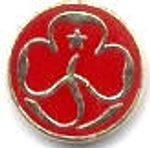
From 1994 they had a promise badge featuring a trefoil on red mock-enamel, in order to show their role in the Guiding family.
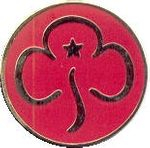
From 2005 the Promise badge featured the newly-introduced trefoil on red mock-enamel, again in line with the other sections who had also introduced the new-style logo onto their badges. The mock-enamel was actually plastic, attached to the metal badge with a rubber-solution glue.

In March 2023, Girlguiding launched new branding, and with it, new Promise Badges for each section – and Trefoil Guild were included in the rebranding, with new Promise Badges for them too, retaining their traditional red colour.
Other Promise Badges
Various other Promise Badges have been issued over the years, some of these are:
Lone Promise Badges
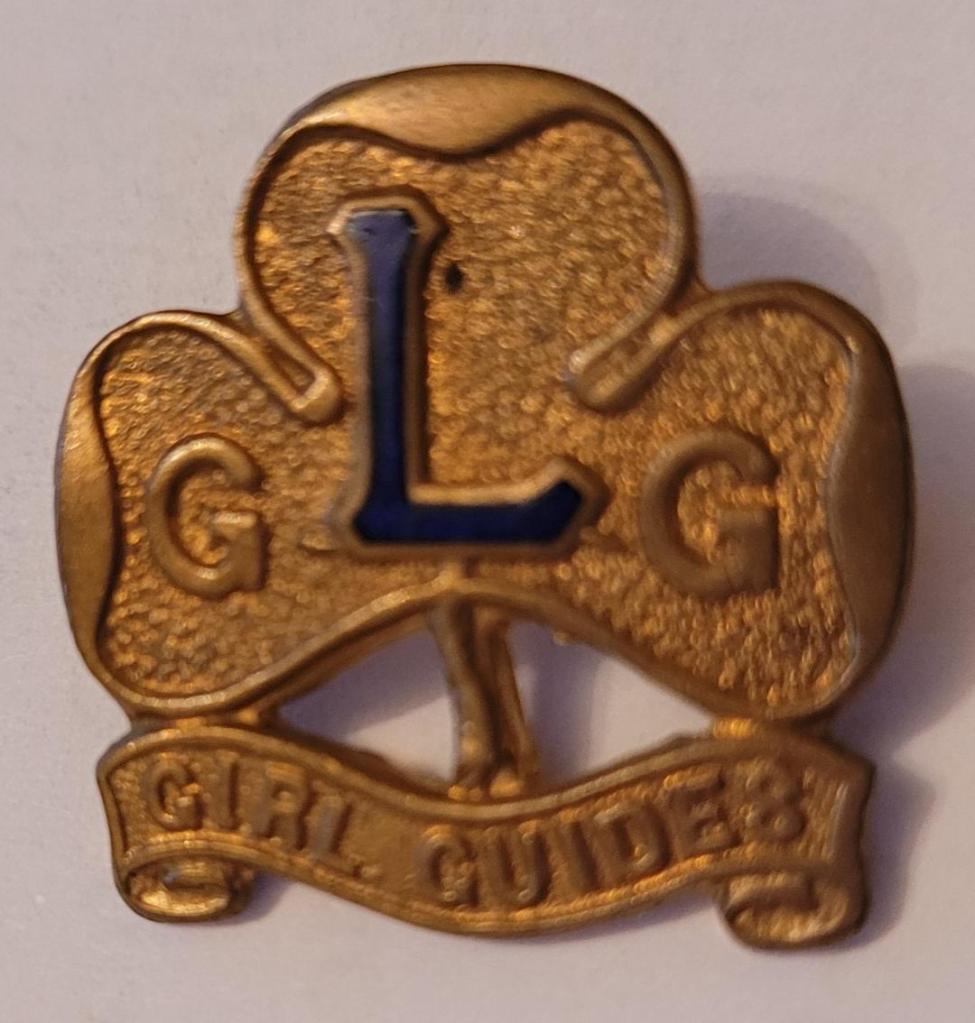
Until 1994 these featured a large enamelled letter L superimposed on a trefoil – the colour of the enamel indicating which section they applied to. So the Guide Lone Promise Badge had a blue L.
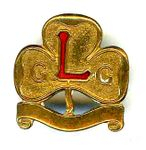
The Lone Ranger Promise Badge (yes, there were Lone Rangers) had a red L, as with the Land Ranger badges. Lone badges had lettered or unlettered scrolls according to the era, but did not feature a star.
More recently, Lone Guides have worn a round woven cloth badge, in the same style as a pre-2002 Guide Patrol badge, with a curly ‘L’ set on a trefoil.
Extension Promise Badges

Extensions was the name originally given to the section specially created for Guides with disabilities – because the Guiding programme and activities were ‘extended’ to incorporate them. Some of these Guides would belong to special Extension units, based in a school or home for the disabled, or in a long-stay children’s hospital (at the time it was not uncommon for ill or disabled children with some conditions to spend months or years in hospital), others might be housebound, at a time when many disabled children did not receive any formal schooling. Housebound Extension Guides would often receive their ‘meetings’ by post, where possible local units were encouraged to adopt and visit them too. Their promise badges had lilac enamel. Gradually the girls were absorbed into mainstream Guiding as far as possible, and from 1968 they wore standard Promise badges for the section they belonged to. These Extension badges can easily be mistaken for Air Ranger Promise Badges, as there is quite a lot of variation of shade of enamel in both sorts – collectors beware!
Local Association Promise Badges
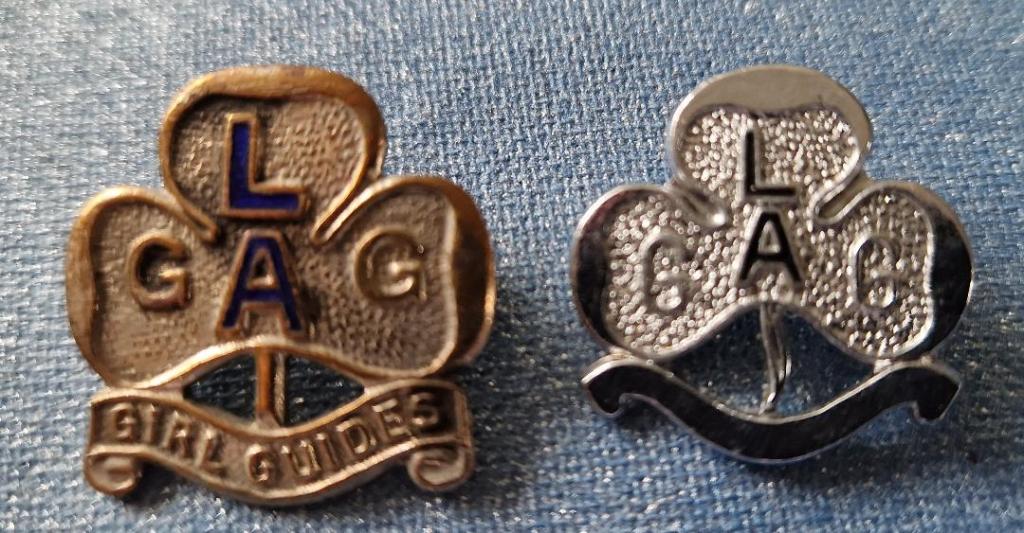
These feature the letters LA in dark blue enamel, set on a silver trefoil. Local Associations were supporters’ groups who worked to help units or Districts with fundraising, admin and other background work – they are now known as ‘Friends of Guiding’. It is not clear when these Promise Badges were introduced, but they certainly existed before 1968, and they seem to have been withdrawn in/by 1994.
Commissioner Promise Badges
These were in the same style as Guide Promise Badges of the given era, but were silver-coloured.
Originally they appeared with the B-P lettering.
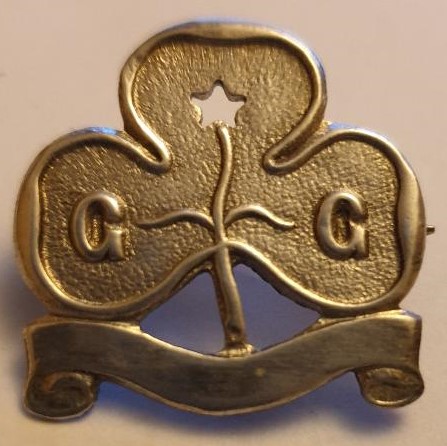
The next style had the broad unlettered scroll, but now has the GG lettering and the star, which represents the 10 Guide laws, just as with the Guide Promise badges of the era.
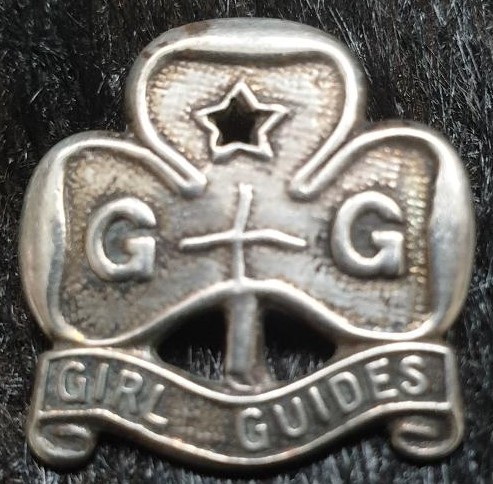
From 1932 onwards, the broad scroll was lettered. At these time, the badges were still made of genuine silver.
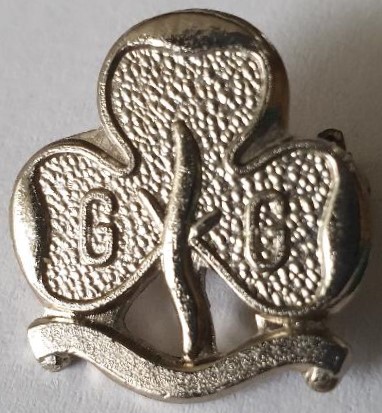
From 1968 they featured the new trefoil with the narrow scroll. These continued in use until 1994, which separate Commissioner Promise Badges were dropped, and all Leaders used the Leader Promise Badge.
Gold Promise Badges
From early in Guiding’s history, special Promise Badges were available for presentation or as gifts, which were made of genuine hallmarked gold. These were far more expensive than regular Promise badges, so would not have been widely used, but they may occasionally be seen in collections.